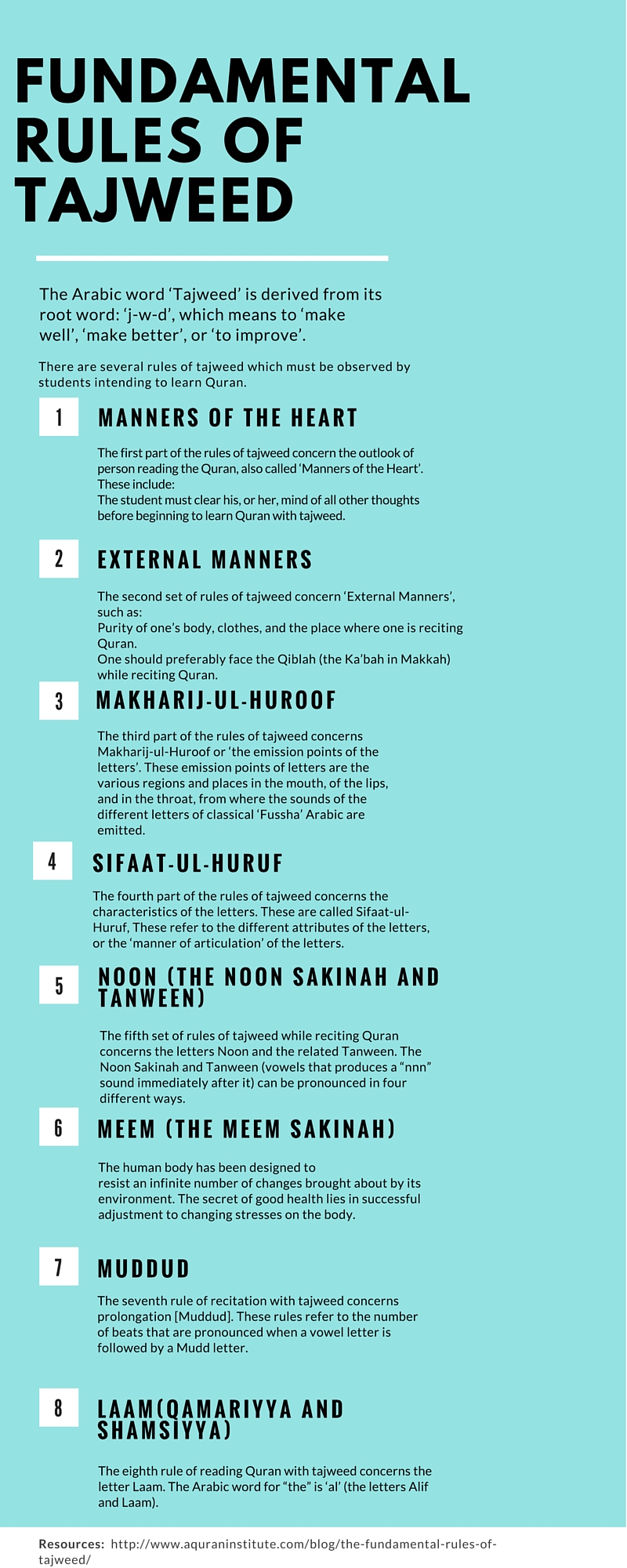
The Quran is the speech of Allah in the Arabic language. People who strive to learn Quran are the most fortunate people on the earth because they are striving to understand the most profound source of knowledge in the whole universe in the words of Creator of all the worlds! That is why proper Tajweed is obligatory while learning how to read Quran. With the rules of tajweed, you can learn and read Quran in a better way.
Since the Quran is the speech of Allah, Subhan a Hu WA Ta’alah, it is extremely necessary to pronounce the Arabic words of the Quran exactly, accurately, and correctly, so that their meaning is not distorted, nor any disrespect caused to the Lord of all the worlds, due to mispronunciation.
The art of correctly pronouncing the Arabic letters and words of the Quran is called ‘Tajweed’. It is recommended that students who want to learn Quran begin their lessons with the Noorani Qaida which is one of the best sources of teaching tajweed.
The Noorani Qaida helps in learning the proper pronunciation of Arabic words, their proper articulation, proper inflection, proper accent, emphasis on letters and words at the right time and place, as well as recitation at the proper pace.

The Arabic word ‘Tajweed’ is derived from its root word: ‘j-w-d’, which means to ‘make well’, ‘make better’, or ‘to improve’. There are several simple rules of tajweed which must be observed by students intending to learn Quran.
The first part of the rules of tajweed concern the outlook of person reading the Quran, also called ‘Manners of the Heart’. These include:
The second set of rules of tajweed concern ‘External Manners’, such as:
The third part of the rules of tajweed concerns Makharij-ul-Huroof or ‘the emission points of the letters’. These emission points of letters are the various regions and places in the mouth, of the lips, and in the throat, from where the sounds of the different letters of classical ‘Fussha’ Arabic are emitted.
The fourth part of the rules of tajweed concerns the characteristics of the letters. These are called Sifaat-ul-Huruf, These refer to the different attributes of the letters, or the ‘manner of articulation’ of the letters.
The fifth set of rules of tajweed while reciting Quran concerns the letters Noon and the related Tanween. The Noon Sakinah and Tanween (vowels that produces a "nnn" sound immediately after it) can be pronounced in four different ways.
The sixth set of tajweed rules while reading Quran concern the letter Meem. The Meem Sakinah can be pronounced in three different ways.
The seventh rule of recitation with tajweed concerns prolongation [Muddud]. These rules refer to the number of beats that are pronounced when a vowel letter is followed by a Mudd letter.
The eighth rule of reading Quran with tajweed concerns the letter Laam. The Arabic word for "the" is ‘al’ (the letters Alif and Laam). The Laam in ‘al’ is pronounced if the letter following the al is "Qamariyya" (lunar), but silent if the letter following the al is "Shamsiyya" (solar). Qamariyya and Shamsiyya refer to the shape of the Arabic letters.
The ninth and final set of tajweed rules concern the thickness and thinness of pronunciation of the Arabic letters. Some of the Arabic letters are always pronounced thick with a heavy accent (Tafkhim), while some letters are pronounced thin with a light accent (Tarqeeq).
The benefits of online Quran learning via a Quran tutor are that one can learn Quran with Tajweed and the correct way of pronouncing words of Quranic Arabic without leaving one’s home, or at a place of one’s own choosing. One can learn to read Quran from an online Quran academy or a Quran teacher at one’s own pace of learning, taking as much time as one is comfortable with.